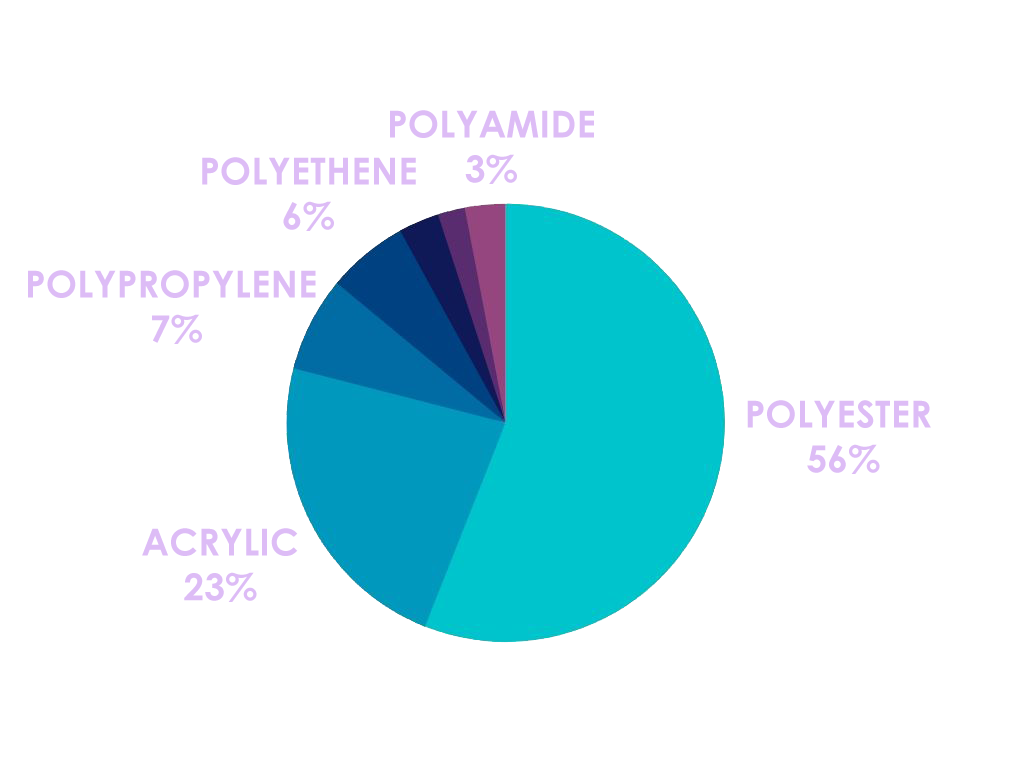Microfibers in Marine Ecosystems
by Clara Petriccione
The Planetary Boundaries concept identifies nine global priorities relating to human-induced changes to the environment. These nine processes and systems regulate the stability and resilience of the Earth System — the interactions of land, ocean, atmosphere and life that together provide conditions upon which our societies depend.
This research will focus on the “Introduction of novel entities”, specifically micro plastics in marine ecosystems, in connection with the textile industry.
MICROFIBERS IN MARINE ECOSYSTEMS
Microfibers are a form of microplastics that come from the fragmentation of synthetic fibers. Due to their petroleum-based origin, microfibers are emerging pollutants with widespread distribution in the environment that cause adverse ecological impacts. Approximately 2 million tonnes of microfibers are released into the ocean every year from various sources.
Textiles release fibres to the environment during production, use, and at end-of-life disposal. Approximately two-thirds of all textile items are now synthetic, dominated by petroleum-based organic polymers such as polyester, polyamide and acrylic – Graph 1 represents different fractions of synthetic fabrics in the ocean.
Due to their resistance to biodegradation, the amount of microfibers in nature is critically increasing with time. Several recent studies revealed the omnipresence of microfibers in various marine environments, sludges, sediments of rivers, oceans, atmosphere and top soil.
Microfibres enter the aquatic environment as both primary sources – fibres < 5 mm in size released during production and use of textiles – and secondary sources involving fragmentation of larger items such as discarded clothing. Fragmentation through chemical and physical forces, such as photodegradation and abrasion, reduces plastic polymer materials to increasingly smaller particles that persist but are difficult to detect and analyse.

Most of the microfibers found in marine ecosystems are released from textile industries, with other key sources including household laundering, textile production, landfills located near the water source, domestic drainages, and dumping off of used clothes in rivers and oceans.
POTENTIAL THREAT TO AQUATIC ANIMALS AND HUMAN LIFE
The mechanisms for ecological and human health effects of microplastics are generally poorly understood but are likely multifaceted. Impacts on ecosystems and effects on human health are shown to be possible via a range of pathways in marine, freshwater and terrestrial environments (Fig 1).
Synthetic microfiber particles are highly dangerous, as they are prone to contaminate the food chain and many aquatic lives are affected by this type of pollutant. As per the reports of International Union for Conservation of Nature (IUCN) 2017, approximately 2 g of microfibers are released whenever synthetic jackets are washed, and of that, 40% microfibers enter into the water bodies. Fish, shellfish, and other large oceanic animals mistakenly take up the microfiber particles as food. These are absorbed in the tissue of aquatic creatures, which humans consume as food. Similarly, several birds that are reliant on little fishes are inadvertently ingesting these microfibers.
Some of the past studies have shown that the fish or other seafood taken up by humans can cause several diseases linked with hormonal disruption, reproductive problems, nervous tissue, liver and kidney damage, because of microfiber exposure.

CONCLUSION AND POSSIBLE SOLUTIONS
Although public consciousness and better consumer education will go a long way in making people aware of the problem of microplastic and microfiber pollution, there needs to be more research into fabrics that are more environmental friendly.
Various studies focus on analysing and quantifying the shedding from synthetic fabrics and how to get rid of the problems that arise due to microfiber pollution. This issue can be tackled at multiple levels – the companies that produce plastic fabrics, the clothing companies that use and sell products made out of synthetics, consumers themselves, washing machine companies, municipal wastewater treatment plants, and more.
However, the microfiber problem has created an opportunity for the development of some novel solutions. For example, products such as Guppy Bag, are aimed to filter the microfiber release from domestic laundry. Emerging research is also now beginning to engineer enzymes with enhanced capacity to degrade plastic polymers such as polyethylene terephthalate (PET), a form of polyester.
However, at this time the lack of commercial-scale solutions means that plastics continue to accumulate in ecosystems where they remain for periods from a few decades up to thousands of years. It would be of significant importance to take a more strategic view, by addressing fundamental questions on how we produce, use and dispose clothing and other textiles in a more environmentally sustainable way. This approach may be more effective in reducing exposure to microfibres in the long-term, avoiding irreversible changes in the stability and resilience of the Earth System.
SOURCES:
Biber, N., Foggo, A. and Thompson, R. (2019) “Characterising the deterioration of different plastics in air and seawater” Available at:
https://www.sciencedirect.com/science/article/abs/pii/S0025326X19301687
Haap, J., Classen, E., Beringer, J., Mecheels S. and Gutmann, J. (2019) “Microplastic Fibers Released by Textile Laundry: A New Analytical Approach for the Determination of Fibers in Effluents” Available at:
Henrya, B., Laitalab, K. and Kleppb, I. (2019) “Microfibres from apparel and home textiles: Prospects for including microplastics in environmental sustainability assessment” Available at:
https://www.sciencedirect.com/science/article/pii/S004896971834049X
Mishra, S., Rath, C. and Das A. (2019) “Marine microfiber pollution: A review on present status and future challenges” Available at:
https://www.sciencedirect.com/science/article/abs/pii/S0025326X19300451
Reimonn, G., Lu, T., Gandhi, N. and Chen,W. (2019) “Review of Microplastic Pollution in the Environment and Emerging Recycling Solutions” Available at:
Shirvanimoghaddama, K., Motamedb, B., Ramakrishnac, S. and Naebea, M. (2020) “Death by waste: Fashion and textile circular economy case” Available at:
https://www.sciencedirect.com/science/article/pii/S0048969720308275
Zabala, A. (2018) “Ocean microfibre contamination” Available at:
https://www.nature.com/articles/s41893-018-0071-7
Zambranoa, M., Pawlaka, J., Daystarbd, J., Ankenyb, M., Chengc, J. and Vendittia, R. (2019) “Microfibers generated from the laundering of cotton, rayon and polyester based fabrics and their aquatic biodegradation” Available at:
https://www.sciencedirect.com/science/article/abs/pii/S0025326X19301614
